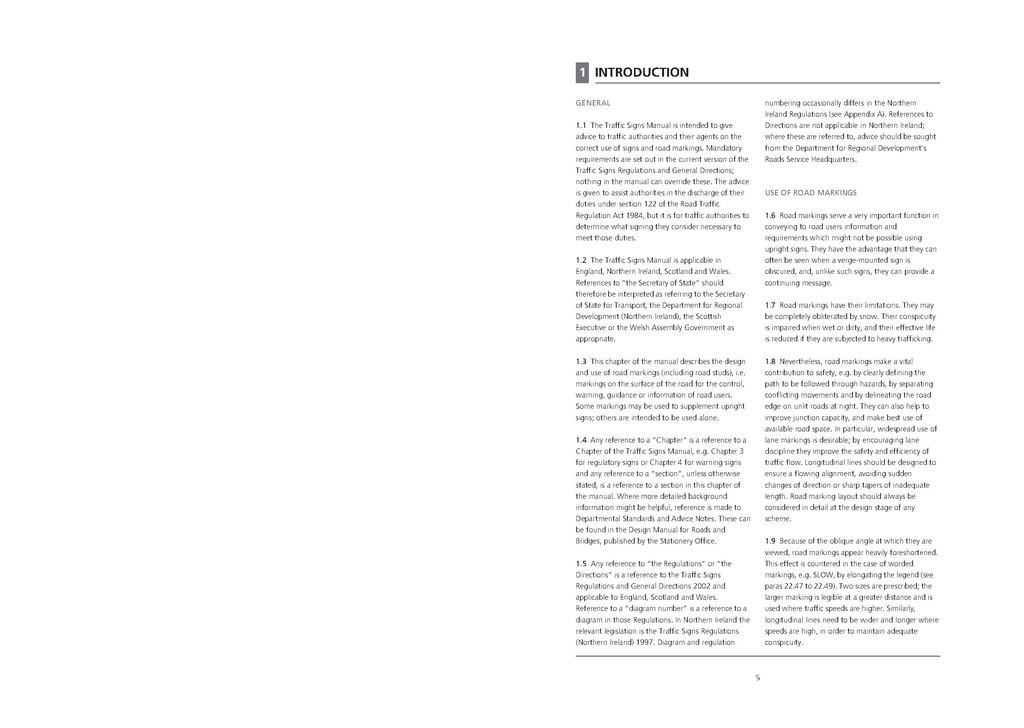1INTRODUCTION
GENERAL
1.1 The Traffic Signs Manual is intended to give advice to traffic authorities and their agents on the correct use of signs and road markings. Mandatory requirements are set out in the current version of the Traffic Signs Regulations and General Directions; nothing in the manual can override these. The advice is given to assist authorities in the discharge of their duties under section 122 of the Road Traffic Regulation Act 1984, but it is for traffic authorities to determine what signing they consider necessary to meet those duties.
1.2 The Traffic Signs Manual is applicable in England, Northern Ireland, Scotland and Wales. References to "the Secretary of State" should therefore be interpreted as referring to the Secretary of State for Transport, the Department for Regional Development (Northern Ireland), the Scottish Executive or the Welsh Assembly Government as appropriate.
1.3 This chapter of the manual describes the design and use of road markings (including road studs), i.e. markings on the surface of the road for the control, warning, guidance or information of road users. Some markings may be used to supplement upright signs; others are intended to be used alone.
1.4 Any reference to a “Chapter” is a reference to a Chapter of the Traffic Signs Manual, e.g. Chapter 3 for regulatory signs or Chapter 4 for warning signs and any reference to a “section”, unless otherwise stated, is a reference to a section in this chapter of the manual. Where more detailed background information might be helpful, reference is made to Departmental Standards and Advice Notes. These can be found in the Design Manual for Roads and Bridges, published by the Stationery Office.
1.5 Any reference to "the Regulations" or "the Directions" is a reference to the Traffic Signs Regulations and General Directions 2002 and applicable to England, Scotland and Wales. Reference to a "diagram number" is a reference to a diagram in those Regulations. In Northern Ireland the relevant legislation is the Traffic Signs Regulations (Northern Ireland) 1997. Diagram and regulation numbering occasionally differs in the Northern Ireland Regulations (see Appendix A). References to Directions are not applicable in Northern Ireland; where these are referred to, advice should be sought from the Department for Regional Development's Roads Service Headquarters.
USE OF ROAD MARKINGS
1.6 Road markings serve a very important function in conveying to road users information and requirements which might not be possible using upright signs. They have the advantage that they can often be seen when a verge-mounted sign is obscured, and, unlike such signs, they can provide a continuing message.
1.7 Road markings have their limitations. They may be completely obliterated by snow. Their conspicuity is impaired when wet or dirty, and their effective life is reduced if they are subjected to heavy trafficking.
1.8 Nevertheless, road markings make a vital contribution to safety, e.g. by clearly defining the path to be followed through hazards, by separating conflicting movements and by delineating the road edge on unlit roads at night. They can also help to improve junction capacity, and make best use of available road space. In particular, widespread use of lane markings is desirable; by encouraging lane discipline they improve the safety and efficiency of traffic flow. Longitudinal lines should be designed to ensure a flowing alignment, avoiding sudden changes of direction or sharp tapers of inadequate length. Road marking layout should always be considered in detail at the design stage of any scheme.
1.9 Because of the oblique angle at which they are viewed, road markings appear heavily foreshortened. This effect is countered in the case of worded markings, e.g. SLOW, by elongating the legend (see paras 22.47 to 22.49). Two sizes are prescribed; the larger marking is legible at a greater distance and is used where traffic speeds are higher. Similarly, longitudinal lines need to be wider and longer where speeds are high, in order to maintain adequate conspicuity.
5
